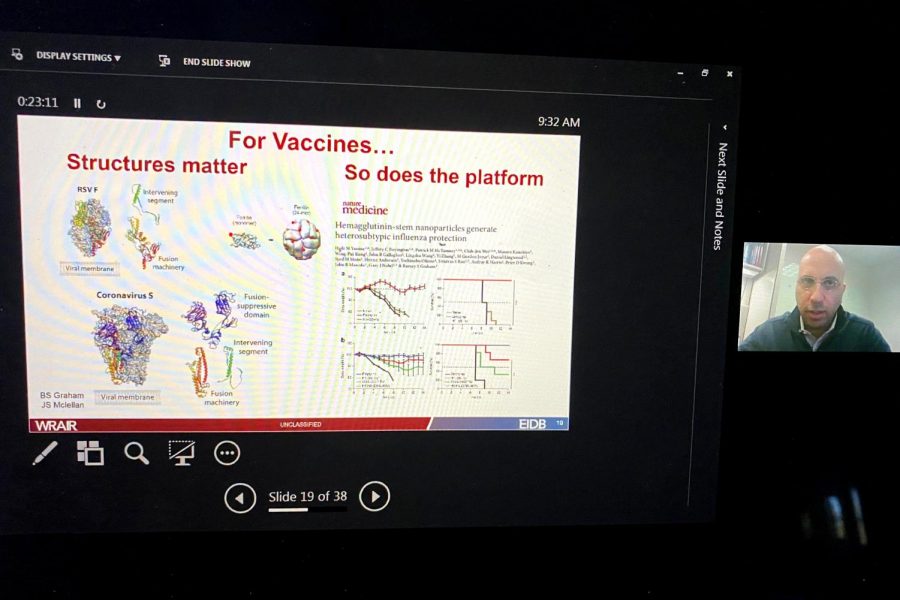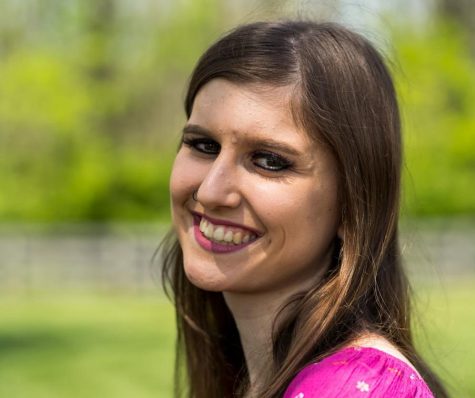Doctor leading the Army’s COVID-19 vaccine team speaks to IU medical community
The IU Office of Vice President for Research and IU Federal Research Relations hosted Dr. Kayvon Modjarrad, who discussed WRAIR’s work with COVID-19.
Dr. Kayvon Modjarrad shows a slideshow about his institution’s COVID-19 vaccine. He discusses that the structure and the platform of the virus matters the most when creating the vaccine.
September 30, 2020
Dr. Kayvon Modjarrad spoke to IU system faculty in biomedical research on Wednesday, discussing the Walter Reed Army Institute of Research’s (WRAIR) work with emerging infectious diseases and its efforts to create a COVID-19 vaccine.
Why WRAIR is Important:
The Walter Reed Army Institute of Research mission is to try to help those who are in the Army and to prevent the spread of viruses.
Dr. Kayvon Modjarrad, the director of the Emerging Infectious Disease Branch (EIDB) at Walter Reed Army Institute of Research (WRAIR), works to support the health and medical readiness of U.S. forces by executing benchtop-to-expeditionary militarily relevant biomedical research and product development for infectious disease countermeasures and brain health promotion.
Modjarrad discussed the EIDB’s vision, which is to develop research and figure out ways to avoid emerging infectious diseases that could be harmful to the U.S. Military.
WRAIR Work with COVID-19:
Modjarrad covered what the EIDB is working on with the COVID-19 vaccine. He talked about the Spike Ferritin Nanoparticle (SpFN), which is their vaccine for COVID-19 that is on track to start human trials later this year.
They have conducted trials with the SpFN vaccine with mice to test immunogenicity and make sure that there were no reactions to the vaccine being given.
According to their preclinical to clinical timeline that was presented, WRAIR is supposed to start phase 1 trials as soon as Dec. 2020. Phase 1 trials help establish preliminary data such as the safety of the vaccine and in what dosage it should be given.
Modjarrad said the many different teams of scientists currently working on a COVID-19 vaccine are using different vaccine platforms. Some are using a nucleic acid platform, while others are using a viral vector platform, inactivated platform, or a protein platform.
The way the EIDB is approaching this vaccine is through the protein platform. By approaching this vaccine through a protein platform, Modjarrad said this method of vaccine production takes longer than others, but that the benefit was more focused in response to the virus.
Operation Warp Speed:
Modjarrad covers how they are a part of Operation Warp Speed (OWS). OWS was established by President Trump in May 2020.
OWS, a response to COVID-19, is a plan to produce and deliver 300 million doses of a COVID-19 vaccine to the American public by January 2021.
Modjarrad said, “I am also a part of OWS on their vaccine working groups, in which I’m helping other companies advance their vaccine. So that is the unique thing in the government is that we do not have our own bottom line. We do our own intramural research but at the same time we are a part of the federal government.”
Modjarrad discussed the years of emerging infectious disease experience that helped prepare him to lead the Army’s response to COVID-19. He has previously worked with diseases such as Yellow Fever, Zika, Ebola, and Tick-Borne Encephalitis.
Their Ebola vaccine, Modjarrad said, was one of the largest infectious disease responses his institution has ever made. “We have done more Ebola vaccine trials than any other institution in the world,” he said.
The event wrapped up with a brief Q&A session, and before leaving, Modjarrad provided his contact information and encouraged anyone with questions to reach out to him.



